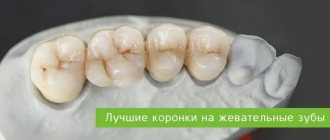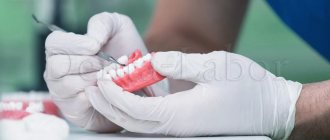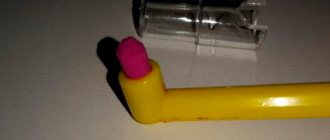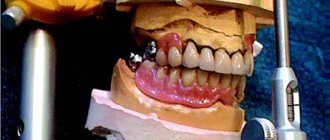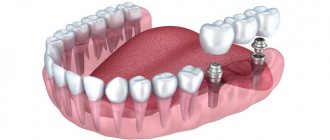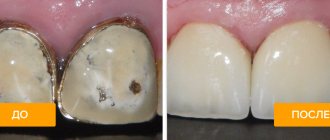Home → Articles → Clasp prosthetics: indications, advantages
In modern dentistry, among the available diversity in terms of prosthetics, clasp dentures occupy a leading position due to their stability and reliability. Good fixation of the device on the jaw is due to its design features.
This type of prosthetics is recommended as a treatment for periodontal disease, one of the main symptoms of which is a loose tooth. With its help, neighboring teeth are supported and the process of transmitting the chewing load is not disrupted. It is not difficult for dentists to recommend clasp prosthetics to a patient, because all its contraindications and indications are clearly defined.
Sign up for a consultation at the dental clinic “Stomatolog11” in the Northern Administrative District:
Make an appointment
What is clasp prosthetics?
A distinctive feature of the clasp is comfortable wearing, which is achieved thanks to the reduced volume and thickness of the base.
A clasp denture is one of the types of removable structures, the basis of which is a metal arch with plastic fragments imitating gums and artificial teeth fixed on it.
A clasp is a metal arch that follows the shape of the jaw. The purpose of the prosthesis is to restore teeth, both in the upper and lower rows.
In addition to the metal base and simulating fragments, the design has fixing elements that ensure strong fastening of the arch in the oral cavity.
The orthopedic product represents a worthy alternative to removable plate and flexible nylon prosthesis.
A distinctive feature of the clasp is its comfortable wearing, which is achieved thanks to the reduced volume and thickness of the base.
The basis of the clasp design performs several functions simultaneously:
- connects artificial gum fragments and teeth;
- provides support for the prosthesis;
- stabilizes the position in the oral cavity.
When making lower row prosthetics, the arch is located on the side of the tongue (at the midpoint between the bottom of the mouth and the level of the gum edge). The parameters of the arc are adjusted (made narrower or wider) so as not to create discomfort to the frenulum of the tongue.
The prosthesis for the upper dentition has a palatal bridge. It connects the saddle-shaped points of the structure and corrects the chewing load, bringing it as close as possible to the physiological one.
What are clasp dentures and what do they look like?
These are removable structures used to restore included and terminal defects of the dentition. They are lighter and more comfortable than plate prostheses with a “sky”, and are in demand in cases where prosthetics on implants cannot be performed.
With the help of a clasp prosthesis, chewing function and aesthetics are restored both in the anterior and lateral sections of the jaw. In the smile zone, they most often use prosthetics from one to three consecutive teeth, and in the lateral sections - longer areas (3-5 missing teeth on one or both sides).
Externally, it is a simple design consisting of a metal arch and plastic imitation of gums with artificial teeth. The absence of a “sky”, characteristic of plate dentures, makes the clasp a lighter and more compact option. You get used to it faster and feel less discomfort. It does not interfere with conversation and is hardly noticeable in the mouth.
Varieties and design features
There are several types of clasp-type dentures, the difference between which lies in the method of fixation:
- On clasps - the design includes metal hooks that provide fixation of the product to the supporting teeth on both sides simultaneously. During installation, grinding of the supporting teeth is not carried out.
- On the attachments , the product has micro-locks that ensure reliable fastening. Due to their small size, the fasteners are almost invisible. When chewing, the load is distributed mainly on the supporting units.
- On telescopic crowns , the prosthesis is fixed using special telescopes. These products are considered the most reliable, but the cost is very high, which is explained by the complex manufacturing technology and virtuosity of calculations. Before installing the structure, it becomes necessary to grind the supporting teeth, cover them with metal and polish them. Only highly qualified specialists can perform high-quality work (interaction between a dentist and a dental technician).
- Splinting - the arch of the prosthesis exactly follows the shape of the teeth, which ensures reliable fixation of the units. This factor determines the cases when installing a prosthesis is appropriate, namely tooth mobility.
On telescopic crowns
On attachments
On clasps
Splinting
Price
The price of clasp prosthetics depends on the degree of complexity of the clinical case - the number of defects, their location, selected materials and manufacturing technology. Prices for prosthetics start from 50 thousand rubles.
The final cost of treatment is also influenced by the preparation and depulpation of supporting teeth for a crown, concomitant treatment of caries, gum and periodontal diseases, and bleaching for the optimal choice of shade of polymers.
You can find out how much a clasp prosthesis will cost in your particular case and ask any questions you have by consulting with an orthopedist in our clinic. Call to make an appointment at a time convenient for you. We'll be happy to help!
Types of locks, lock fastenings
Clasps for the upper jaw are available in several versions, which differ mainly in shape:
- ring;
- horseshoe-shaped;
- in the form of a transverse strip.
Designs with clasps are considered the most common.
Varieties of this group differ in retaining elements:
- Roach's clasps look like T-shaped extensions that extend from the frame arc and are placed in recesses. The products provide good fixation, but the process of placing them is quite complicated.
- Bonneville clasps represent a group of reversible structures. Crossing the occlusal surface transversely, they are placed on the vestibular and oral parts of the incisor (molar). It is appropriate to use in cases where there is a gap between the teeth. The clasp fills it completely, which eliminates the accumulation of food residues.
- Reichelman clasps are distinguished by their transverse design and the presence of an occlusal lining in the form of a special partition.
- Continuous clasp - the design is made up of several links fastened together. The product is placed orally or vestibularly. The peculiarity lies in the tight fit of each link to natural teeth, which ensures strong fixation.
- Embrasure clasps are essentially a type of Bonneville clasps, but the two elements included in the design are directed in opposite directions. The products perform a stabilizing function, so they are often used for splinting.
Continuous clasp
Embrasure clasp
Bonneville clasp
Roach's clasp
Reichelman clasp
Splinting prosthesis
A feature of clasp dentures is the possibility of their use in prosthetics of moving teeth (lateral and anterior). Often, with loose teeth, this method of prosthetics is the only one.
The splinting method is used for chronic inflammatory and degenerative processes (periodontal disease, periodontitis), when teeth become painful and mobile.
Fixation of mobile teeth in the case of installation of clasps occurs due to a thin arc located on the inner surface of the teeth and repeating their shape. This additional arch holds the teeth in the desired position and helps stabilize their health.
By what parameters is the variety selected?
To solve problems with loose teeth, a splinting prosthesis is more suitable
Each type has a number of advantages, but the cast design is considered the most reliable, so when choosing the type of fastening, preference should be given to a solid product.
To solve problems with loose teeth, a splinting denture is more suitable.
Its design is created in such a way that natural teeth are fixed in their natural position.
With prolonged exposure of the units to the units, the neck of the tooth in the dentin is strengthened. The same products are recommended in case of malocclusion. The stabilizing properties of the arch make it possible to correct the defect during prolonged wear.
A locking design is chosen for partial loss of teeth, when several units are missing in a row. It is appropriate to use a clasp when there are supporting teeth, which will allow you to redistribute the load on them during chewing.
Removable clasp prosthesis for the lower jaw - consider in detail
Why is a denture for teeth called clasp? The name itself comes from the word “arc”. It is based on a thin cast arc-shaped metal element, onto which a plastic base imitating gum is fixed, as well as artificial crowns - smooth and beautiful teeth. Thanks to the arch, the teeth replacement system is highly durable and reliable, because it will have to be removed and put on at least once a day. As a result, the patient receives a compact, lightweight, comfortable prosthesis for the lower jaw, which is easy to get used to in the first few hours after installation.
How is the prosthesis fixed on the supporting, pre-prepared teeth of the lower jaw? Using hooks or special elements. They are placed on top of the patient’s teeth or on pre-implanted implants. By the way, the prosthesis locks themselves are made not only of a metal alloy, but also of plastic, which is especially important for people with an allergic reaction to metal. But the gums can be made of either nylon or plastic bases (acri-free, quadrotti solutions). When it comes to dental crowns, they are usually made from a plastic material that imitates enamel.
It is important! The specificity of the prosthesis for the lower jaw presupposes that the arch is located on the side of the tongue, that is, where it is not visualized at all. The distance from the arch to the cervical area of the teeth is approximately one millimeter, and a little more is the distance to the bottom of the mouth.
Types of clasp dentures
Dental prostheses are classified according to various criteria, including the type of material used in the production process of the orthopedic product:
| Types of clasp prostheses | |
| Name | Description |
| Metal-free (quadrotti) | The main element of the prosthesis is made of polymer material, which makes it possible to use the design for allergy sufferers. |
| Metal-containing | Various dental alloys are used to make dentures: titanium, cobalt chromium, gold and platinum. |
| Plastic | The base consists of acetal. This product is lightweight and comfortable to wear. |
| Metal-ceramic | In the process of making a prosthesis, a combination of metal and ceramics is used. This improves the aesthetic qualities of the orthopedic design. |
What does a clasp prosthesis consist of, what materials are used in its manufacture?
A modern clasp prosthesis, made from high-quality materials, looks quite aesthetically pleasing. It consists of four parts.
- Frame (clasp). Durable, thin and light. It includes: a cast arch that evenly transfers the load to the jaw in places of missing teeth, slowing down the processes of bone resorption;
- mesh for attaching artificial teeth, allowing you to create a single structure;
- fasteners (clasps, beam structures, telescopic crowns, anchor and magnetic clamps) for rigid, elastic or hinged fastening on supports (healthy teeth, implants, crowns);
- splinting elements (according to indications - claw-shaped hooks, clasps, Elbrecht splints).
Materials for making a prosthesis
- Frame, fasteners. Using classical technology, the base of the structure is made of metal using modern casting methods. Depending on individual tolerance and other criteria, alloys of noble metals, cobalt-nickel-chrome with minor impurities, as well as titanium are used.
Currently, there are more modern materials - thermoplastic polymers, which are not inferior in strength to metal, but are more elastic and comfortable. The most famous are ACETAL or Dental D from QuattroTi.
- Base. It is made using classical technology - hot polymerization from acrylic, and in modern versions, like the frame, from thermopolymers.
- Teeth. Plastic, composites.
The choice in favor of one or another material is determined by the individual sensitivity, wishes and financial capabilities of the patient.
Types of fastenings
All orthopedic prostheses in dentistry are divided into groups:
- removable;
- fixed;
- partially removable.
Clasp structures belong to the third group, since removal is carried out only to perform hygienic procedures. Patients easily cope with this task with one movement of the hand. There is no need to remove the denture at night.
When chewing food, emotional conversations and expressions of joy (laughter), there is no need to worry about the reliability of the fixation. The prosthesis is firmly held by fastenings.
Patient reviews
Konstantin, Moscow. I used partially removable dental structures for 2 years until the need for prosthetics arose. Every person who wants to preserve the beauty of their teeth eventually faces the procedure. The doctor installed the bulge prosthesis for 3 weeks. There was no pain when installing the structures, since there was no need to grind the supporting units. I wear a denture and don’t notice that it’s in my mouth. I didn't have any adjustment period at all. The doctor allowed me to consume familiar foods (including those with dyes). I only excluded toffees and chewing candies from my diet.
Artemy, Samara. The dentist advised me to install a bulge denture on the lower jaw after I lost 1 molar. The doctor said that this particular design would be optimal in my case, since it would prevent premature loosening of neighboring elements. I have been wearing a plastic device for 3 years and can only note one drawback - the need to get used to the material. The adaptation period took 3-4 weeks. After that everything returned to normal.
Sergey, Tver. I did not appreciate the advantages of the design. The bulge denture did not hold well in the oral cavity and constantly moved when speaking. It was difficult to chew rough food and bite off large pieces of fruits and vegetables. I have been wearing the design for 1 month and hope that I will get used to it in the near future. I had to refuse implants due to the structural features of the jaw structures.
Tatyana, Orel. I wanted to restore my lower chewing teeth using bulge dentures. It took me about 1 month to get used to the new designs and even went to bed with them. The doctor dissuaded me from installing the consoles, citing the possible loosening of adjacent teeth. I noted the convenience of the system and the almost complete absence of discomfort when chewing food. The denture is simply removed and placed back in the mouth. Caring for it also does not cause much trouble.
Clasp prosthesis with splinting
In the absence of a large number of teeth in a row, the patient is recommended to install a clasp denture on implants
During dental prosthetics, problems with soft tissues (periodontitis, periodontal disease) are often identified.
As inflammation progresses, the gums become red and swollen, and a gap forms between it and the teeth.
In this case, a decision is made to install a splinting structure that tightens the units, preventing them from loosening.
In the absence of a large number of teeth in a row, the patient is recommended to have a clasp denture installed on implants.
First, implants are implanted in those places of the gums where support for the prosthetic structure is needed (if there are no units at all, 4 implants are required, in other cases 2 pieces are enough).
The operation is performed using local anesthetic. After the soft tissue has healed, a prosthesis is installed. For these purposes, the most suitable options are designs on attachments or beam fastenings.
How to care for clasp dentures with locking fixation
To extend the life of removable structures, they must be cleaned after each meal, at least 2 times a day - morning and evening. They are cleaned with a toothbrush and rinsed thoroughly under running water.
The structures are disinfected in a special antiseptic solution, which eliminates bacterial plaque and prevents corrosion and the appearance of dark spots.
Toothpaste should not contain abrasives or aggressive chemical compounds such as soda or citric acid. These components can react with the alloy constituents and cause oxidation, causing dark spots to appear on the surface. The toothbrush should not be hard - the slightest scratches and microcracks also reduce the service life of the denture and worsen the aesthetic impression.
After installing clasp structures on locks, it is advisable not to drink large quantities of coffee, tea and other drinks containing dyes. It is also necessary to stop smoking. The dark plaque formed during use cannot be removed at home and requires a visit to the dentist for proper cleaning.
To check the stability of the attachment and the condition of the bone tissue, you should visit an orthopedic dentist once every 6 months. At the appointment, you can carry out professional cleaning of the supporting teeth and comprehensive cleaning of the clasp structure.
On the upper jaw
Dentures for the upper jaw are made from openwork casting using durable medical alloys
Clasp prosthetics of the upper row is performed in the absence of one or more teeth.
If there is no tooth, 4 implants are implanted. The prosthetic structure at the location of the artificial teeth is fixed to the jaw, and the arch itself is fixed to the palate.
Among all types of clasp products, attachments and splinting dentures are popular when restoring the upper jaw.
Clasps meet functional needs, but significantly lose in aesthetics. Therefore, they are rarely used for the top row.
Dentures for the upper jaw are made from openwork casting using durable medical alloys.
The connecting element (palatal membrane) does not cover the entire surface of the palate, which makes the process of adaptation quick and comfortable. The peculiarity of upper jaw prosthetics is a more complex technique for performing the work.
Clasp prosthetics of the lower jaw are easier. The design of the prosthesis looks simpler; it lacks the palatal part. The entire load is borne by the supporting teeth, to which the product is fixed. All types of clasp dentures are suitable for restoring the lower dentition.
Telescopic fixation system
This fastening system is the most complex and modern. In this case, telescopic crowns are made of two parts in contact with each other. One part of the crown (lower, non-removable) is installed in the supporting teeth, and the other (upper, removable) is firmly fixed to the metal plate of the clasp.
When fastening, the upper part of the telescopic crowns fits tightly onto their lower part. Shrinkage of the fastening when installing a removable structure ensures reliability and strength of fixation. And although this type of fastening is not cheap, it serves reliably for a long time and only needs minor correction.
Unfortunately, for Russia this type of fastening is still new and is used infrequently. To work with these types of clasp fastenings, you need a highly qualified orthodontist. But in America and Europe, telescopic mounts are already common and familiar.
Advantages and disadvantages
Experts highlight the following advantages of clasp-type dentures:
- uniform distribution of chewing load throughout the entire jaw;
- aesthetics, which is achieved by equipping the structure with tiny fasteners;
- comfortable wearing, which is ensured by the small size of the metal frame;
- strength and reliability (the metal arc can withstand regular and heavy loads, unlike polymer analogues).
The disadvantages of clasp structures may not appear if the preparatory work for installing the prosthesis and measurements are performed at a high level. Most of the complaints from patients are related to calculation errors by the dentist.
As for the prosthesis itself, despite its strength, sometimes there are cases of clasps breaking. Such a defect cannot be repaired; the entire structure must be replaced.
The disadvantages are also attributed to the high cost of the product, but it is quite justified. The metal arc casting process involves the use of high-tech technology that requires high precision.
This ensures the strength and reliability of the prosthesis, hence the long service life, which is fully compensated by comfortable wearing.
Advantages of clasp structures
So, patients and orthodontists note the following advantages when using clasp structures:
- Comfortable: The thin metal base arch allows the palate to be open. This ensures that patients can continue to enjoy food and live in style.
- The use of a metal arch does not interfere with diction and prevents unpleasant moments associated with the sudden loss of the prosthesis.
- Strength: the strength of the arch allows you to protect the prosthesis from breakage.
- Duration of service: up to 5 years of wearing the structure, which is considered a record period for removable dentures (for plastic types, the wearing period usually does not exceed 2-2.5 years).
- Slowing down the atrophic processes in the gums and jaws, which preserves the possibility of wearing the plates for the longest possible time.
- There is no need for daily removal at night.
- Rare cases of stomatitis.
- A splinting prosthesis on clasps allows you to strengthen teeth when they become loose.
- Excellent fixation of the prosthesis with different types of fastenings (clasp, lock or telescopic system).
Prices
The cost of a clasp prosthesis is represented by a wide price range, which is explained by several factors:
- An important role in pricing is played by the regional factor, the status of the clinic and the qualifications of the dentist.
the complexity of manufacturing the product;
- type of fastening;
- materials used;
- complexity of the design.
An important role in pricing is played by the regional factor, the status of the clinic and the qualifications of the dentist.
Average prices for clasp dentures (for 1 jaw):
- clasp - 30,000-35,000 rubles;
- splinting – 45,000 rubles;
- on locks - 62,000-65,000 rubles;
- on telescopic crowns – 65,000 rub.
Fixation methods
The properties of the clasp, as well as service life, cost, and comfort of use depend on the method of fixation in the oral cavity. The dentist is faced with the task of reliably installing the structure so that it remains stable during functions - eating, talking. And also choose a fastener that will not have a negative effect on the teeth, gums, and mucous membranes.
Clasp fixation
The most affordable is the clasp denture. The elements are small but very durable hooks made of metal or plastic. The clasps cover the supporting crowns and thus securely hold the prosthesis. There are various support-retaining clasps, which differ in shape, type, and location.
The most important thing for high-quality prosthetics is to choose the right type of clasp. To do this, the dentist and technician carry out special methods for examining jaw models. The condition of the dentition, the number of missing teeth, the route of insertion of the prosthesis, the location of the defect and the boundary line, the presence of antagonist teeth, occlusal contacts, etc. are taken into account.
Clasps are a simple and reliable method. The disadvantage is the lack of aesthetics. In the anterior part of the jaw (in the smile area), the hooks may be noticeable.
Locking system
During the treatment process, special locks are used - attachments. The products consist of two parts - internal and external. One part is installed in the prosthesis, and the second in an artificial crown on the supporting tooth. When dressing, the mechanism clicks into place. Locks provide reliable fixation and stabilization of the structure by attaching to natural teeth, roots or implants. The method has many advantages:
- Excellent aesthetics;
- The castles are completely hidden from others;
- The smile looks beautiful and natural;
- Reliability and strength;
- Possibility to replace the lock;
- Long service life.
The disadvantage is the need to cover the supporting teeth with artificial crowns, strict requirements, complex manufacturing process, and relatively high cost.
- Telescopic crowns
The most aesthetic, high-quality and expensive treatment method is the use of clasp on telescopic crowns. The products are a special system of two crowns, one of which is placed on the supporting tooth, and the second is located in the frame of the prosthesis. These crowns precisely match each other and snap into place when the product is put on. Stabilization of the structure is ensured by the vertical walls of the crowns.
During use, chewing pressure is evenly distributed over the jaw, which prevents atrophy. Telescopic crowns are invisible to others, so the prosthesis is very aesthetic.
Beam fixation
Another reliable fastening method is the beam system. It consists of 2 parts: a fixed beam and a metal matrix in the prosthesis frame. The beam is attached to the crowns of the supporting teeth, and the matrix completely repeats the shape of the beam. When applying the clasp, the structure snaps into place, fixation and stabilization are ensured.
Contraindications
There are restrictions on the installation of clasp dentures.
They concern the following cases:
- if the patient has a deep bite;
- in the presence of pathological processes in soft tissues and on the oral mucosa;
- when supporting teeth are missing or if they are low;
- with severe jaw atrophy;
- with a high location of the attachment point of the frenulum of the tongue;
- if there are inflammatory processes in the mouth;
- when the floor of the mouth is shallow;
- with stubborn mucosa in the area of missing teeth.
A contraindication to the installation of an arched structure is the presence of an allergy to one of the components used in the production of the prosthesis, for example, to metal.
During the examination, the orthopedist may postpone prosthetics for the following reasons:
- due to pregnancy;
- if the patient uses drugs;
- during the patient's treatment with radiation therapy.
Installation of prostheses of all types becomes impossible with the following health conditions:
- if the patient is diagnosed with mental disorders;
- diabetes;
- in the presence of problems with the respiratory system, occurring in an acute form;
- oncology;
- exacerbation of diseases of the cardiovascular system.
Indications and contraindications for installation
The choice in favor of clasp dentures is made in the presence of dentition defects, both single (1-3 teeth - Quadrotti’s “butterfly”), and multiple – included and terminal bilateral.
Contraindications:
- metal allergy;
- complete absence of teeth;
- atrophic processes in the jaw;
- inflammatory diseases of the gums and periodontium;
- low height of supporting teeth, insufficient for prosthetics.
Many contraindications apply to classic metal prostheses. The use of technologically more advanced thermoplastic options expands the range of indications for installation.
Care, repair and service life
It is recommended to carry out hygiene procedures at least 2 times a day
The process of caring for a clasp-type prosthesis is simple, but requires regular attention.
Throughout the day, bacteria accumulate in the oral cavity, which leads to the development of inflammation of the mucous membrane and the formation of an unpleasant odor.
At night, salivation decreases, as a result of which plaque appears on the teeth and structures.
Timely cleaning of the mouth using special means: toothpaste and brush, dental floss, mouthwash balm will help get rid of complications.
It is recommended to carry out hygiene procedures at least 2 times a day, and after each meal you need to rinse your mouth with water.
To prevent the surfaces of the prosthesis from wearing out prematurely, it is better to purchase pastes with a mild action (not aggressive). Once every six months, you should contact a specialist for professional cleaning of the oral cavity, especially for coffee lovers, because the drink changes the color of artificial teeth (turn yellow).
During wear, the prosthesis may break. The reasons are different, but they are all provoked by a sharp mechanical impact on the structure. The possibility of repair depends on the severity of the product failure.
The main types of breakdowns include:
- broken metal fasteners;
- formation of a crack anywhere in the structure;
- detachment of artificial teeth;
- damage to the lock part;
- fracture of the prosthesis into two parts.
The service life of the prosthesis with proper care is 5-10 years.
Manufacturing and installation process, stages of work
Preparation
The creation of a clasp prosthesis begins with the planning stage. The patient's oral cavity undergoes a thorough examination. Orthopantomography and CT scanning of the jaw will help to examine all its anatomical features and ongoing processes.
It is important to know:
- Causes of tooth loss. This will help protect the supporting crowns from caries, as well as periodontal and periodontal diseases.
- The degree of their mobility. If necessary, the frame is supplemented with hooks, tires and other fasteners.
- Presence of jaw atrophy. In advanced cases, clasp prosthetics is not recommended. Only implantation can help.
If any diseases are revealed during the examination, sanitation of the oral cavity is required before prosthetics. Professional hygienic cleaning is also recommended, which will reveal the natural color of the patient’s tooth enamel in order to correctly select acrylic, thermopolymers or composite materials.
Impressions
To work, it is necessary to obtain two-layer anatomical impressions, with the help of which working models are made and the degree of fit, load distribution, compression level and other important parameters of the functionality of the prosthesis are subsequently controlled. The impression is taken using an individual tray.
Working model
Using super plaster, two working models are created based on the impression. One of them is used in the process of planning and modeling the frame, as well as installing dental crowns - up to the complete production of a partial denture. And the second is needed to check the cast metal frame.
Subsequently, using the plaster model as a basis, an identical one is made in a dental laboratory, but from refractory ceramics. With its help, wax modeling of the frame is carried out, taking into account all clasps, branches, retention meshes, fastening processes, occlusal pads and other elements, and subsequent metal casting is also performed.
Frame formation
Making a refractory ceramic model on top of the primary one with a wax model of the frame allows you to create space for pouring metal in exact accordance with the frame drawings. Subsequently, in an induction furnace or using other technology and equipment, the metal is heated to the required temperature and poured into the mold.
After cooling, the surface is processed to remove mold residues and polished until an ideal fit to the working model is achieved, and then in the oral cavity during fitting.
Basic requirements for this:
- compliance with original drawings;
- absence of defects (sagging, cavities);
- ideal fit on the support and prosthetic bed;
- no problems when closing the dentition.
Formation of the base and installation of dental crowns
Artificial teeth are installed on a finished metal frame using a wax roller, and then the base of the clasp denture is modeled, taking into account the characteristics of the patient’s gums (size of interdental papillae, periodontal ridges).
Then, after checking the correctness of the created design by trying it on with the patient, the prosthesis is plastered and the wax is replaced with acrylic. The finished result must be aesthetic and correspond to the drawing conceived at the very beginning.
Checking the prosthesis for fit and installation
The finished prosthesis is tried on a model, and then the fit in the oral cavity is assessed. The result is considered ideal if the prosthesis is as similar as possible to the tissue in the patient’s oral cavity. It must be perfectly polished, match the color scheme of natural tooth enamel and periodontal tissues, fit accurately onto the support and prosthetic bed, and ensure ideal occlusion. After the final fitting, the finished product is polished and then secured in the patient’s mouth.
Consultation
The dentist at our clinic will definitely instruct the patient on how to care for the clasp denture in order to maximize its service life. Will answer any question and remind you of the need for professional hygienic cleaning of dentures. This will save artificial teeth for many years.
Which prosthesis is better, clasp or nylon?
Both types of prostheses deserve attention, but the nylon design is considered more modern. This is due to a number of factors: lightness, comfortable adaptation in the mouth and easy wearing, no problems with rubbing soft tissues in individual nodes.
And caring for nylon is easier than with the metal version. Although the chewing load is better distributed by a clasp type product.
If we consider the main advantageous characteristics of nylon prostheses, they outweigh their metal counterparts in the following indicators:
- hypoallergenic;
- flexibility, elasticity;
- low probability of breakdown;
- The transparency of the material increases aesthetics.
There are also not many disadvantages to nylon prostheses, but they are significant. For example, it is no longer possible to repair a broken product. And the price of new ones is steep.
Stages of prosthesis manufacturing
Correction of the dentition with metal arches is only possible if the patient has supporting elements on both sides. Otherwise, it will be difficult to fix the system in the mouth. The process of making a bulgel takes from 1 to 3 weeks.
Before installing the product, the dentist notes all the structural features of the elements in the oral cavity and adjusts the structure to them. During the splinting process, the patient must visit the dental clinic several times
The prosthesis production process itself consists of several stages:
- Preparing the oral cavity for the procedure. The oral cavity is examined and the necessary parameters are calculated to select the optimal orthodontic design. The dentist cleans plaque from the supporting units and makes impressions for the lower jaw.
- Making casts from plaster or wax. The model is made in a three-dimensional projection, from which the specialist makes the frame of the future prosthesis.
- Fitting and fitting of the corrective system. After eliminating all the deficiencies, the specialist replaces the wax part of the system with a plastic or metal one.
- Installation of the device in the oral cavity, its grinding and polishing.
What is important to pay attention to!
The most important part of the clasp prosthesis is its metal frame with a fixation system built into it. Initially, the frames of clasp dentures were made only by casting, for which a cobalt-chromium alloy (CCH) was used. Nowadays, the method of one-piece casting on a refractory model is still widely used, but more modern methods have now appeared that make it possible to increase the accuracy of the manufacture of this prosthesis in the dental laboratory.
For example, frames can be made using the modern method of “selective laser melting”, not only from CCS, but also from titanium. The use of titanium made it possible to both increase the strength of the metal frame (titanium is 5 times stronger than KHS) and reduce the weight of the clasp prosthesis by approximately 2 times. Reducing the weight of the prosthesis greatly facilitates getting used to it. Another modern method of manufacturing a metal frame for partial dentures, as well as caps for telescopic crowns, is milling on a computer-controlled machine (CAD/CAM technology).
You need to find out which method will be used to make your particular prosthesis during your initial consultation with your dentist. As a rule, small clinics that have their own dental laboratory do not have special milling equipment and a machine for selective laser melting (due to their high cost). We hope that our article: Clasp dentures reviews, price – was useful to you!
Sources:
1. Personal experience as a dentist, 2. “Orthopedic dentistry. Textbook" (Trezubov V.N.), 3. National Library of Medicine (USA), 4. https://www.realself.com/, 5. "Removable dentures: a textbook" (Mironova M.L.), 6 "Teeth restoration with clasp dentures (Fadeev R.A.).
The process of getting used to the clasp prosthesis - features and nuances
The process of getting used to a clasp denture installed on the lower jaw is not at all quick. At first, the patient may be bothered by excessive salivation and discomfort while chewing food. There may also be speech defects - it is difficult for a person to pronounce hissing and whistling sounds. Also, at first you may feel a slight rubbing of the oral mucosa, but this is normal.
If discomfort when wearing dentures bothers you for more than a week, you need to visit a dentist. The system may need to be adjusted slightly to resolve the discomfort.
